Roz Morris's Blog, page 113
February 20, 2011
Let your MC succeed while they're failing – the power of reward
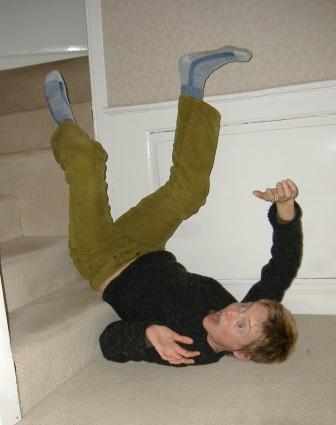
Hmmm... is there an upside to being upside down?
I've been chatting with Jonathan Moore about plots and he asked this very good question: Do you think the idea of worsening failures needs to be applied comprehensively for a plot to be compelling? What happens if you give the MC a break now and then?
Most plots feature struggles – things go from bad to worse. The hero tries to do something (or stops something happening), and that kicks off a series of events that escalate. But Jonathan has identified an important point here.
Before the MC finally gets what they want (or doesn't), you have to give them a break.
There are two reasons.
1 Predictability
A plot can seem too predictable if all we see is failure after failure. The reader can get bored, not to mention punch-drunk. And for a story to have momentum, the reader needs the feeling that things are changing – a story of novel length needs to, as I said a few weeks ago, move the goalposts. So unless you specifically intend to bludgeon the reader with misfortune (which I find Thomas Hardy's novels do), the MC needs some rewards before the end.
But variety isn't the only reason to cut the MC some slack.
2 Giving rewards makes a story more compelling
Often, giving the MC rewards can kick off an even better story. He wants something, he seems to get it. He gets more embroiled and that leads him into deeper do-do.
In Andrea Newman's An Evil Streak, a lonely single man has a creepy, obsessive relationship with his niece. When she was a child she was his angel. She bursts into puberty and starts dating, and he's abandoned and jealous – the first blow. But then she falls in love and needs a place to sleep with her boyfriend. Kind, creepy uncle offers her his flat – a triumph as she is in his power like never before. Even better, he puts up a two-way mirror and watches. The rest of the story is a seesaw of successes that ensnare him more and scrapes that make the failures worse.
A perhaps less amoral example is The Unit by Ninni Holmqvist. The Unit features a futuristic world where childless single people are given at age 50 to medical science. They live in the lap of luxury while undergoing medical experiments, and will eventually make the ultimate sacrifice as organ donors. The story follows a woman who goes into such a clinic… and falls in love. Suddenly she has found what she has missed all her life – but is it too late? She is given hope, has those hopes dashed, is given more hope again… and the reader is right with her on the rollercoaster, heart leaping and stomach lurching.
This early success – where the character seems to get what they want, makes what unfolds so much more powerful. By involving us in the successes, the failures become more devastating.
Who else might you give a break to?
Giving a character a break is used to very interesting effect in Thomas Harris's Red Dragon, which became the first Hannibal Lecter film. For much of the novel we have watched the murderer Francis Dolarhide as an appalling monster. Then, unexpectedly, he strikes up a relationship of genuine tenderness with a blind girl. This goes to the very root of what he needs in life and lets us see a human side to him (while also making us afraid for the poor girlfriend as we're sure she's going to trigger his vicious instincts at any moment). Just as we wonder if this will redeem him, he sees her talk to a colleague and gets jealous – and then we know that as far as he is concerned, the universe has betrayed him and nothing will stop him. And that makes him even more formidable.
Rollercoasters need ups as well as downs. So when you're making things worse for your characters, don't have them fail all the time. Explore what happens if you give them what they want – and snatch it away. Maybe do it several times. Thanks, Jonathan, for a provocative question as always!
Share your favourite examples of characters being rewarded!








February 19, 2011
How I got my agent – guest post at Guide To Literary Agents
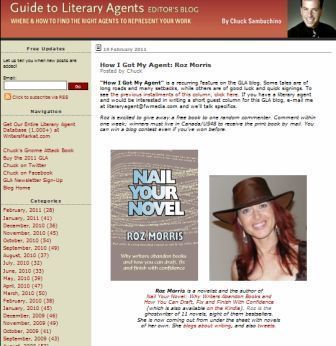 I've been guesting again. Today I'm at Chuck Sambuchino's Guide To Literary Agents. Chuck is an editor for Writer's Digest Books, a playwright and the author of How To Survive A Garden Gnome Attack. I'm thrilled to bits to be featured today, talking about my search for that holy grail, agently representation.
I've been guesting again. Today I'm at Chuck Sambuchino's Guide To Literary Agents. Chuck is an editor for Writer's Digest Books, a playwright and the author of How To Survive A Garden Gnome Attack. I'm thrilled to bits to be featured today, talking about my search for that holy grail, agently representation.
Getting an agent isn't easy. Some people query for a year and feel they've reached the end of the line.
Me? A year is nothing.
Hop on over and see. As a bonus, if you comment on the post there, you'll be entered in a draw to win a print copy of Nail Your Novel.








February 13, 2011
Kindle Nail Your Novel now on sale!
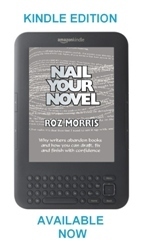 Some people would say it's about time too, as for a while now I've been getting requests to put my book Nail Your Novel onto the Kindle.
Some people would say it's about time too, as for a while now I've been getting requests to put my book Nail Your Novel onto the Kindle.
What took me so long? Two things.
1 – I don't have a Kindle
But I've been knocking around writing blogs for long enough to know that we like our own ways of reading. People who read on the Kindle want their books in that format and some of them don't even buy print any more. At the moment I prefer paper and print, but other people prefer pixels.
2 – Design
I designed the print version of Nail Your Novel with sections and sub-heads, identified by typefaces – a legacy from my years in magazines. As the Kindle does away with typefaces, how was I going to make it look right? The very thought of it was nailbiting.
Until I happened upon this blog post by Cath Ryan Howard of the blog Catherine, Caffeinated: How to format your e-book without the migraine. She made it look so simple I thought I'd have a go. She also references the Smashwords Style Guide, which filled in the whys and wherefores and is so darn clear that it deserves a plain English award. It's deesigned for epub, but the principles also hold for the Kindle. With these open on my desktop, I had most of what I needed. Even with my complicated format, it was easy peesy.
 I'm not going to rehash their instructions as they've done the legwork and deserve the site hits. I'll just mention a few points that weren't covered, although most of these will apply to non-fiction rather than fiction:
I'm not going to rehash their instructions as they've done the legwork and deserve the site hits. I'll just mention a few points that weren't covered, although most of these will apply to non-fiction rather than fiction:
Yes, bold and italics will work on the Kindle. Apply them as you normally would in Word with the toolbar buttons – they translate just fine.
Bullets don't work on the Kindle. So I rewrote the bullet-point lists as numbered lists.
If you're writing non-fiction you'll need a hyperlinked contents page, and you may want cross-references to increase the book's usability. I found this post from Foner Books answered my remaining questions. You do not need an index as there are no pages, but there are a few electronic markers you need to put in to identify the start of the book. You also need page breaks on a Kindle, which you don't need on an epub book. The Foner Books post explains it all.
Without a Kindle, how could I check it worked? Fortunately the Kindle publishing system has a simulator. Upload your file, check it looks okay, tweak as necessary, upload again. You needn't worry you've published prematurely as you have to go through several more steps to actually launch your book on Amazon. As an extra, a friend converted my file to a format called Mobi and was able to test it on her Kindle. She gave me the thumbs up – and we were ready to go!
So…if you're wondering about putting your book on Kindle, all I can say is do. It really is easy.
Thanks
 Particular thanks in my journey to this Kindle edition go to the people whose excellently written resources made it possible, and to Suzanne Fyrie Parrott of Unruly Guides and Kevin McGill of Guys Can Read. And there are many, many more of you who have given me such wonderful feedback on the book and have cheered me on in reviews and have spread the word. Thank you – I really appreciate it. (And thank you, .bobby, for the picture.)
Particular thanks in my journey to this Kindle edition go to the people whose excellently written resources made it possible, and to Suzanne Fyrie Parrott of Unruly Guides and Kevin McGill of Guys Can Read. And there are many, many more of you who have given me such wonderful feedback on the book and have cheered me on in reviews and have spread the word. Thank you – I really appreciate it. (And thank you, .bobby, for the picture.)
What's it all about?
Read about Nail Your Novel here and read Amazon reviews here
Read the first 16 pages for free here – although on Kindle you can get a sample anyway.
Read reviews from Sarah Peppel (Novel Inspirations from Nail Your Novel) New Book Blogger, listen to me talk about the book to Joanna Penn here. Also I'm going to be popping up in a few guest posts around the virtual town, so stay tuned.
And, one final time, here's where you can buy it in the Kindle Store US and UK.
Although if paper is still your thing, you can find it on Amazon.com here, or if you're outside the US on Lulu here.








February 12, 2011
One song to the tune of another – dos and don'ts of mash-ups and juxtaposition
 Mash-ups or juxtapositions are a good way to get new story ideas. 'This-meets- that…' But flinging random ideas together is more likely to result in a mess than a good tale. Here's how to do it well
Mash-ups or juxtapositions are a good way to get new story ideas. 'This-meets- that…' But flinging random ideas together is more likely to result in a mess than a good tale. Here's how to do it well
One of my favourite party games is One Song to the Tune of Another, from the BBC Radio 4 panel show I'm Sorry I Haven't a Clue. The best combinations deserve to live and breathe on their own, but if you try the game at home (and I do, frequently), you'll find it takes a lot of stabs in the dark to find two songs that are made for each other.
There seems to be a rash of mash-up fiction at the moment, usually involving zombies. No, I haven't read Pride and Prejudice and Zombies, or Robin Hood vs The Plague Undead – and I don't want to. Why? Because the title seems to be the only joke and I can't see where else it would go. Maybe I'm much too serious, but it's not even a very good joke.
Juxtaposition rule 1: be surprising
If you're going to juxtapose two elements, do something original. Phil South wrote this week on his blog Going Down Writing about taking two random ideas and making a story out of them. His result, Jurassic Submarine, is rather good.
Juxtaposition rule 2: not just a one-liner
A good mash-up has to be more than a one-liner. So although you may start with 'this meets that', you need to go a lot further.
Consider Deadwood. That's Shakespearean drama meets the Western – and the two together create something new, deeply right, with legs that will go on for miles.
A lot of great stories have originated in mash-ups, either in ideas or broader concepts. 'Jaws in space' gives you Alien. Jonathan Strange and Mr Norrell by Susanna Clarke is Jane Austen meets Jack Vance. Blood-Red, Snow White by Marcus Sedgwick is Arthur Ransome meets John Le Carre. The whole genre of cyberpunk is film noir meets science fiction. Steampunk is sci-fi meets alternate history. If you're going to mash two ideas together, they have to truly complement and highlight each other. It's anything but random.
In my WIP Life Form 3, I'm mashing two ideas together, but I've spent a long time thinking about what they bring out in each other. There are ways in which the two ideas are compatible and ways in which they are interestingly jarring. Much of the story is generating itself from the fizz when they collide. (And I can't tell you too much more about it at the moment without giving far too much away, which is why I've been very coy about details…)
If you're going to mash two ideas together, they need to fit in some way. And preferably cause as much tension as harmony.
Most random stabs don't work beyond the initial surprise, as I found when challenged to sing The Sound of Music to the tune of Buffy The Vampire Slayer. The first few bars are amusing, but after that there is no coherence that makes it worth continuing.
You have to experiment a lot to find genuine show-stoppers, but here's one: sing the words of Greensleeves to the tune of The Stripper. Try it now.
What mash-ups and juxtapositions, literary or filmic, do you think have genuine mileage?
For a bonus point, give me a good song lyric to sing to the tune of another.








February 11, 2011
Nail Your Novel coming to Kindle on Valentine's day
 By popular demand, my book Nail Your Novel is launching on Kindle on Monday 14 Feb. I'm trying to muster as many people to buy it on that day so that it makes a decent thump in the Amazon charts. So, if you were hoping for a Kindle version would you buy it on the 14th?
By popular demand, my book Nail Your Novel is launching on Kindle on Monday 14 Feb. I'm trying to muster as many people to buy it on that day so that it makes a decent thump in the Amazon charts. So, if you were hoping for a Kindle version would you buy it on the 14th?
Lov e to write? On Valentine's day, Give your book a writing buddy to hold its hand. Ahhh.
e to write? On Valentine's day, Give your book a writing buddy to hold its hand. Ahhh.
Thank you, .bobby, for the picture.








February 6, 2011
When you reach the end of your revision – revise the beginning again

When you see the light at the end, go back to the beginning
A friend of mine who is querying his first novel had a reply from an agent the other day. The agent said his writing was very good, he clearly had talent – but the first chapters had major problems. My poor friend replied: 'Yes, it's a pity those are the chapters I had to send. I revised them first. The ones I'm working on now are much better.'
You don't need me to tell you your first chapters have to sell your book. But they're usually the first chapters you revise, and by the time you've got to the end a whole chunk of time has gone by. Not only that, you've lived with your novel more, played with its scenes, discovered new levels and resonances, understood the characters and the problems of the world.
But when you revised your beginning – or wrote it for the first time – you didn't know any of this.
I'm doing deep edits of Life Form 3. It's been a long journey but finally, I can see the light at the end. I'm now far sharper about what is important in the story, what's irrelevant, what I want to emphasise and what I can ditch.
I last looked at the opening three months ago. Yes, I hammered and pummelled it as hard as I could at the time. I hacked, slashed, tweaked and twiddled for several weeks, in fact. Once I moved on it couldn't have been tighter, more resonant, or more tantalising. Now though, I can see it's not quite doing the job.
While I'm at it, I'm going to skip through the whole first half again. There are scenes that need a slightly different accent. Thematic swirls I now know are clutter. There are slightly more natural places to explain background or history. But most of all, that beginning is going back on the workbench.
Don't be in a hurry
I know we're all keen to get our books out to finally meet readers. I can't wait to let Life Form 3 punch its way into the world; for more than a year it's had only me to talk to. But it's a mistake to let any of it out if it's not right. It's especially a mistake to send out the meet-and-greet chapters before you've even finished the revised draft. Because in order to know what the beginning should be you have to understand all the rest, to the tips of your toes. As my friend found.
Repeat after me: when you reach the end, revise the beginning again








February 2, 2011
Talking to Joanna Penn about nailing your novel
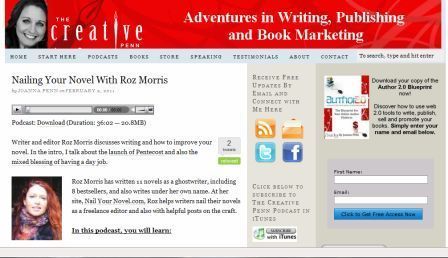 Today I'm Joanna Penn's guest at The Creative Penn podcast. Joanna's interviews are essential listening for me – she's an author, blogger and business consultant who has rejected the traditional publishing route because she found it too slow and difficult. Instead, she set herself the task of learning how to do it all herself.
Today I'm Joanna Penn's guest at The Creative Penn podcast. Joanna's interviews are essential listening for me – she's an author, blogger and business consultant who has rejected the traditional publishing route because she found it too slow and difficult. Instead, she set herself the task of learning how to do it all herself.
Every week she interviews editors, marketing experts and writers about their adventures in publishing and book marketing and has built up a formidable following among all those of us who want to take charge of our publishing careers and make the very best of what the internet can offer us. She's written a brace of books on writing, self-publishing and internet marketing. She's also been realising a long-held dream to write thrillers and her first – Pentecost - is just about to launch.
I'm thrilled she wanted me to be her guest this week. Come and join us as we discuss ghostwriting, tips for writing a bestseller – and how to write your second novel. And whether I mind doing really nasty things to characters…








January 31, 2011
Things we do for fiction… back at Victoria Mixon's
 I'm at the blog of my fellow fiction editor Victoria Mixon, author of The Art & Craft of Fiction: A Practitioner's Manual, for the second part of what turned into a long and rather diverting conversation. In between the goofing we talk about the things we do when writing novels of our own, ghostwriting, bad deals in the publishing world and the time I got hit by a train.
I'm at the blog of my fellow fiction editor Victoria Mixon, author of The Art & Craft of Fiction: A Practitioner's Manual, for the second part of what turned into a long and rather diverting conversation. In between the goofing we talk about the things we do when writing novels of our own, ghostwriting, bad deals in the publishing world and the time I got hit by a train.
It's all here. As you hop on over, mind the gap…








January 29, 2011
How to revise your novel if you can't get into it – take time to dress the set again
 When you left the draft, you were living and breathing the story. When you go back to revise, one of the biggest hurdles is recreating that familiarity. How do you take control again?
When you left the draft, you were living and breathing the story. When you go back to revise, one of the biggest hurdles is recreating that familiarity. How do you take control again?
The email was headed: 'Here's that film you were in!' Hereafter, the Clint Eastwood film in which I was an extra, has just been released, and friends are making my day by sending me links whenever it's mentioned in the press. Yesterday I got an article about a chap in London whose house was used as a location. It had to double for another house already used in the film, and the crew added false tips to the railings, replaced the front door, recoiffed the pot plants and wallpapered the hall.
It struck me that that's a lot like revisiting a novel to do revisions. To start with I feel I don't know the story any more, or live inside the characters, or remember the geography of their world. I have to go through a mental set-building phase in order to feel at home there again.
But I don't just tip into the draft. That keeps me on the outside, like a new reader, and I need to be inside, behind the scenes, taking control of it all. I need to dress the set again. Here's what I do.
1 Never throw your notes away
From the moment I start planning a book I keep copious notes. About the world, the synopsis, the characters. In one novel I'm planning, there's a discography of all the music that exists in the world. When it's time to revise I read them all again.
So many writers I know throw away these files when they send the novel out or hand it to their editor. But it's never too late for somebody to suggest another round of revisions. The only time it's safe to throw away your notes is when the book is between covers.
2 Get out your soundtrack
I need no excuse to make soundtracks for my books. First there are the pieces of music I choose to help evoke the initial mood of the story (and are an excuse to browse the Listmanias on Amazon). Then there are the tracks that grab me while I'm working on the book – a talisman for a particular scene, a theme to connect me to a character. Each of my books has a soundtrack, and I dust it off when I need to reconnect with the book again.
 3 Make a beat sheet – or read an old one
3 Make a beat sheet – or read an old one
There's an exercise I always do before a major edit. It's called the beat sheet, which becomes an at-a-glance blueprint for revision. It helps me take charge of the book again because it focuses on the underlying purpose of each scene. Once I'm done with the revision, I keep the beat sheet because if I need to revisit the draft, the beat sheet helps me rebuild the set again.
Thank you, E Bartholomew on Flickr, for the photo. The beat sheet is one of the tools from Nail Your Novel, Why Writers Abandon Books and How You Can Draft, Fix and Finish With Confidence. Read an excerpt in the widget on the right, and read Amazon reviews of it here
Guys, what do you do to rebuild the set for a revision?








January 25, 2011
Wielding the writing sword at Dragonfly Scrolls
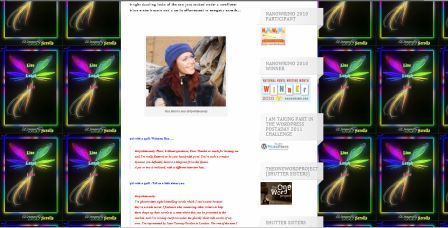 Kim Koning has a zeal to make the world a thoroughly creative place. She lives for writing and art and her blog, Dragonfly Scrolls, has just hit its hundredth post. To say she's prolific is an understatement. She's probably put more words into the ether in a few short months than I have in all the time I've been posting – and she somehow also completed NaNoWriMo. Now Kim has decided to celebrate her blogging centenary by giving herself yet another task – a series of interviews called Warrior Wednesdays.
Kim Koning has a zeal to make the world a thoroughly creative place. She lives for writing and art and her blog, Dragonfly Scrolls, has just hit its hundredth post. To say she's prolific is an understatement. She's probably put more words into the ether in a few short months than I have in all the time I've been posting – and she somehow also completed NaNoWriMo. Now Kim has decided to celebrate her blogging centenary by giving herself yet another task – a series of interviews called Warrior Wednesdays.
I'm honoured to be the first writer chosen to draw the writing sword. Join me on her blog where we talk about how a journalism background both helps and hinders fiction writing, why story rules are like laws of physics, what advice I would give myself as a newbie writer – and what on earth nailing your novel means.











